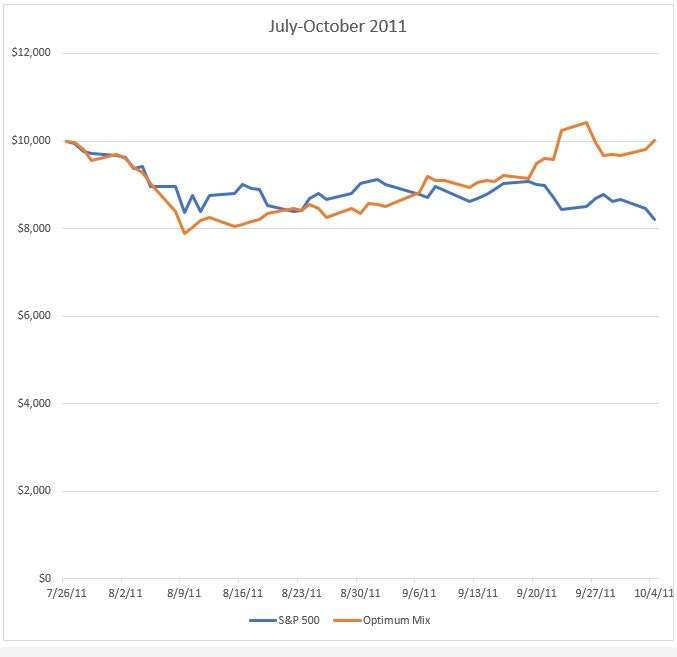This chart compares the loss in value of $10,000 invested in the S&P 500 from July 25, 2011, through October 4, 2011, with the loss in value and then growth of $10,000 invested using the Optimum Mix during that same period._
The market as represented by the S&P 500 fell 17.94% from July 25 to October 4 in 2011.
In our hypothetical backtest, the Optimum Mix actually grew 1.48% during that same period by continuing to invest in high-momentum large cap stocks and by switching a portion of the portfolio from leveraged equity ETFs to a leveraged bond ETF as directed by the algorithm.
The Optimum Mix backtest switched back into leveraged equity ETFs after the end of the black swan event.
Those tactics helped the Optimum Mix recover quickly and go on to also substantially outperform the market in the months and years following the crisis.
While the Optimum Mix showed better performance by the end of the crisis, the leveraged equity ETFs caused the Optimum Mix to fall more quickly than the S&P 500 during the initial weeks of the crisis before those leveraged equity ETFs were exchanged for the leveraged bond ETF.
The strategic takeaway for this period and other speed bumps, corrections, and bear markets is to
“cover your assets.”The time to develop a plan for volatile markets like the one we are in now and the Debt Ceiling Crisis of July-October 2011 is before they begin.
We can learn from the past to prepare for the future.
Any questions or feedback?![]() $ProShares UltraPro S&P500 ETF (UPRO.US)$ $ProShares UltraPro QQQ ETF (TQQQ.US)$ $MicroSectors FANG+ Index 3X Leveraged ETN (FNGU.US)$ $Netflix (NFLX.US)$ $NVIDIA (NVDA.US)$ $Nike (NKE.US)$
$ProShares UltraPro S&P500 ETF (UPRO.US)$ $ProShares UltraPro QQQ ETF (TQQQ.US)$ $MicroSectors FANG+ Index 3X Leveraged ETN (FNGU.US)$ $Netflix (NFLX.US)$ $NVIDIA (NVDA.US)$ $Nike (NKE.US)$ 